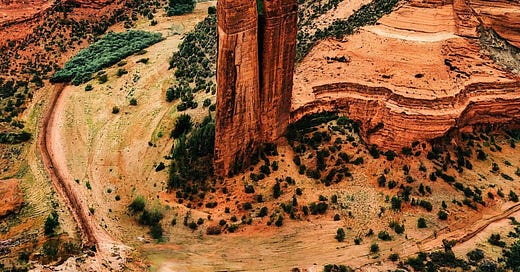When a Cave Became a Tomb in Canyon de Chelly
The story of a Spanish attack on the Navajo in the American Southwest.
In the rugged terrain of northeastern Arizona lies Canyon de Chelly, a place of breathtaking beauty. It is also a place of historical significance. Among its many landmarks, each one more breathtaking than the last, one stands out for its somber history: Massacre Cave. The cave would earn its name from a tragedy that befell the Navajo in 1805.
Canyon de Chelly
Canyon de Chelly (pronounced d’SHAY) has been inhabited for nearly 5,000 years. It was one of the longest continuously inhabited landscapes in North America. It is a place where towering sandstone cliffs rise majestically from the canyon floor. The canyons created a natural fortress that provided shelter and sustenance for its inhabitants. The Navajo people, or Diné as they call themselves, settled in this canyon. There they cultivated its fertile soil and drew spiritual sustenance from its rugged beauty.
Southwest Supremacy
By the early 19th century, the Navajo people faced increasing pressures from external forces. Spanish colonizers, Mexican settlers, and rival Native American tribes all sought control over the Southwest’s valuable resources. The confluence of these desires escalated tensions. Conflicts frequently erupted as these groups vied for dominance.
In the winter of 1804-1805, a Spanish military expedition led by Lieutenant Antonio Narbona was sent to suppress the Navajo people. The Navajo had been raiding Spanish settlements throughout the desert Southwest. Narbona's orders were clear. Subdue the Navajo and secure Spanish dominance in the region.
The Massacre
In January 1805, Narbona’s forces entered Canyon de Chelly. The Navajo, anticipating conflict, had sought refuge in a high, narrow cave located in a side canyon. This cave was a perfect defensible position. It stood high in the canyon walls and was nearly impossible to climb. The Navajo had successfully used the cave with enemies before. But the Spanish were different.
The Navajo’s strategic position proved tragically insufficient against the well-armed Spanish forces. Narbona's men positioned themselves on the opposite canyon rim. From there, they began firing down into the cave. Trapped and unable to return fire, the Navajo were mercilessly gunned down. While estimates vary, the consensus is that no less than 115 Navajo men, women, and children died in the cave.
The details of the massacre are harrowing. According to accounts, the Spanish troops fired relentlessly. The Navajo had little means of escape. Or defense. The cave, once a place of refuge, became a tomb. From that moment on, the cave would be known as Massacre Cave.
Aftermath and Legacy
The Massacre Cave tragedy left an indelible mark on the Navajo. It exemplified the realities of the Navajo-Spanish conflict. However, instead of scaring the Navajo into submission, it had the opposite effect. The event fueled further resistance among the Navajo. And they would continue to rely on Canyon de Chelly’s canyons and geography throughout the 19th century.
Today, Canyon de Chelly is a national monument, protected and preserved for its historical and cultural significance. Visitors to the canyon can explore its stunning landscapes, ancient ruins, and, poignantly, Massacre Cave. Guided tours, often led by Navajo guides, offer insights into the canyon’s rich history and the enduring legacy of its people.
History for the Hurried:
June 20, 1782: The U.S. Congress officially adopted the Great Seal of the United States of America.
June 23, 1865: The last formal surrender of Confederate troops occurred as Cherokee leader and Confederate Brigadier General Watie surrendered his battalion comprised of American Indians in the Oklahoma Territory.




